Archive for the 'Fruit' Category
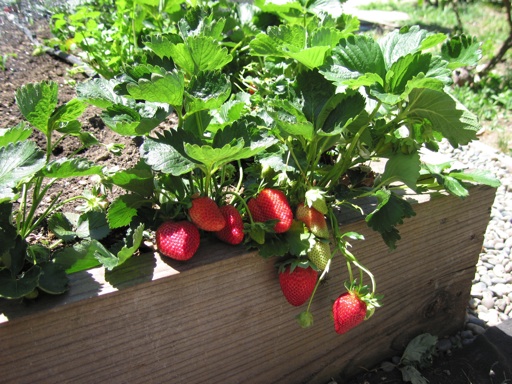
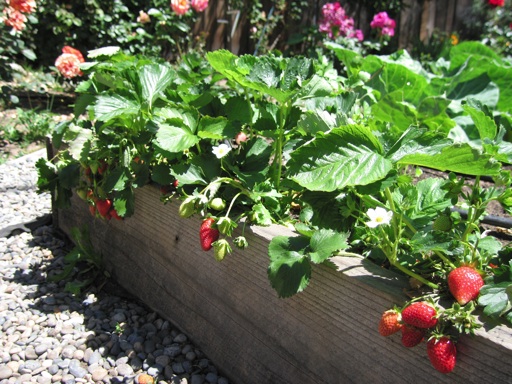
I have been growing strawberries in my backyard for years, but I have never gotten more than about a half a dozen ripe berries before the first week of May. This year, I started getting a few ripe strawberries two weeks ago. Over the past 10 days, I have picked a bowl full of strawberries every few days. I have never had so many ripe strawberries before the end of April.
I attribute the early strawberries mainly to the weather. We have had warmer than average weather for the past couple of months, with many more days in the 70s and 80s in April than we typically receive. The average afternoon high temperatures here in April are in the upper 60s to low 70s. Another factor may be the variety of strawberry that I grow. I used to grow mainly Sequoia strawberries. Now most of my strawberries are Chandler, although I still have some Sequoias. Sequoias have a better flavor, but Chandler has many other advantages that make it my favorite strawberry.
Chandler produces many more berries than other varieties I have grown (which include Quinault, Seascape and Aromas), and its berries are typically larger than Sequoia. Also, Chandler doesn’t grow as many leaves as Sequoia, which makes it easier to find the berries and makes for less cover for snails and slugs to hide in. Sequoias grow lots of medium to small leaves, while Chandler tends to grow fewer but larger leaves. Finally, Chandler berries are firmer than Sequoia and less prone to rotting. I am growing all of my strawberries this year as a border around my raised garden beds.
Most of the strawberry plants I am growing now grew as runners from plants that I bought from a nursery and planted last spring. Although some people say to cut off strawberry runners, I let them grow, because I have found that strawberry runners from the previous year grow well and produce lots of berries in the next season. Often, they produce better than nursery transplants in my experience. And since strawberries only last a few years, you either have to let the runners grow or buy nursery transplants every few years to replace the old ones.
April 30 2013 | Strawberries | Comments Off on Early Strawberries
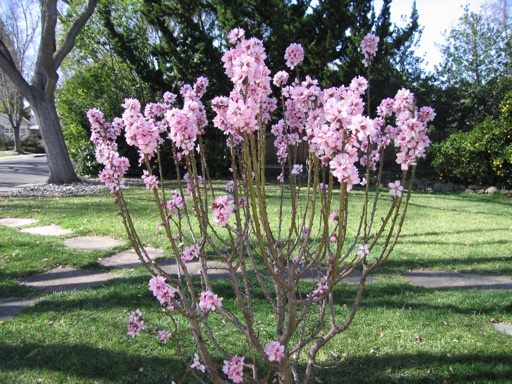
Our Garden Prince dwarf almond tree is in full bloom for the first time. I planted it about 4 years ago. Although it had about a dozen blossoms last February, and even less two years ago, this is the first year that it has been full of blossoms. Garden Prince is a self-fruitful variety, meaning it doesn’t need another variety of almond tree growing nearby to cross-pollinate with in order to set nuts.
Our tree hasn’t set any nuts yet, but I am hopeful that it will set nuts this year. I have never seen almond trees grown in the bay area, at least that I can identify. Although their leaves look very much like peach tree leaves, so they’re hard to spot. I planted this almond tree as an experiment to see if it would set nuts here, and if any nuts that it did set would ripen in our mild summers. I know that almonds usually need hot summers to ripen properly.
We have had more than enough chill hours this winter for almonds. According to the UC David research center, inland parts of the bay area have received between about 900 and 1000 hours below 45 degrees so far this winter (California Chill Hours). The Garden Prince variety is listed as needing only 250 chill hours according to Dave Wilson Nursery.
In any event, even if the nuts it sets are not edible, this almond tree makes a nice landscape plant. It was the first tree to bloom in our yard this year just after Valentines day, and its pink blossoms clustered at the ends of its upright branches are very attractive.
February 24 2013 | Almond | Comments Off on Almond Tree Blooming
What to do with all those apples from your backyard trees? Last month, my mom and I picked hundreds of apples from two 35 year old apple trees in my parents’ backyard. After making a few apple pies, I still had dozens of apples sitting in our refrigerator. Many of them were getting soft and had brown spots on them.
Today, I decided to juice the remaining apples (about 60 of them). We have a juicer device that we rarely use. I cored and sliced the apples, cutting out the brown spots, but not removing the skin. Then, I fed the apple slices through the juicer. Juice comes out one side and the skins come out the other. I made over a gallon of juice. I then heated the apple juice in a pot, and added some sugar and cinnamon, although the juice tasted very good by itself. It turned out very pulpy, which I don’t mind. Homemade juice can be diluted with water and/or strained through a sieve to make it more liquidy.
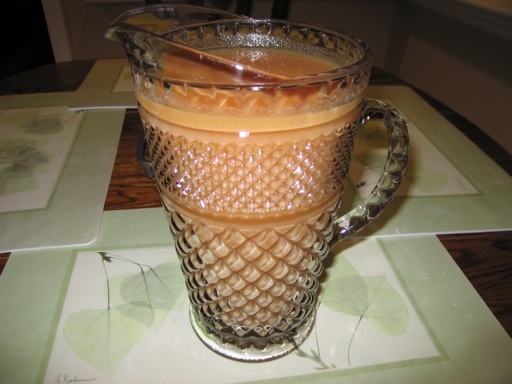
Below is a picture of the 5-year old Fuji apple tree in our backyard. It has about 100 apples this year, although they’re small. I’ve only picked a few of them so far. Last year, it had less apples (about 30), but they were larger. I’ve managed to keep the tree itself very small through pruning and not watering it too much to limit its growth. It’s a semi-dwarf tree that has the potential to grow over 20 feet tall. It’s currently only about 6′ tall x 6′ wide, so it’s still very easy to net and harvest the fruit. Apples of course are well known for growing into very large trees. However, so far I’ve found that at least some varieties of apples are easy to keep small. They still produce a significant amount of fruit despite their small size.
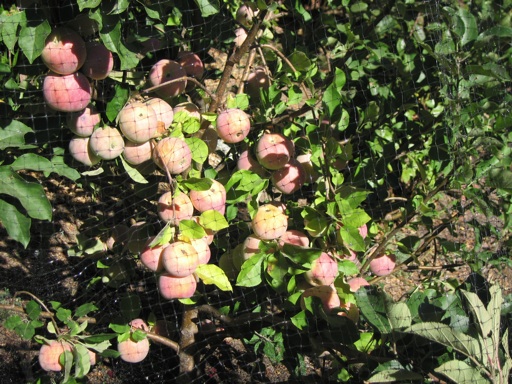
We also have a very small Granny Smith apple tree, which was full of apples a month ago. But I ended up pulling off about 70% of the apples because the branches were sagging to near breakage under the weight of the fruit.
September 15 2012 | Apples | Comments Off on Homemade Apple Juice
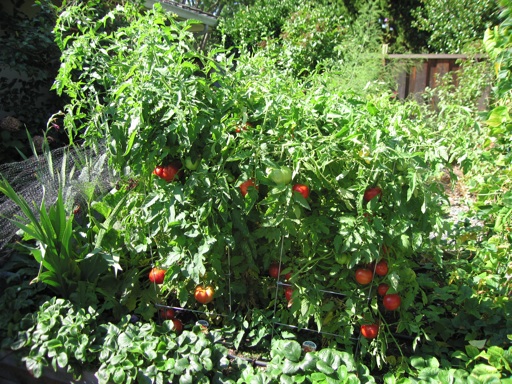
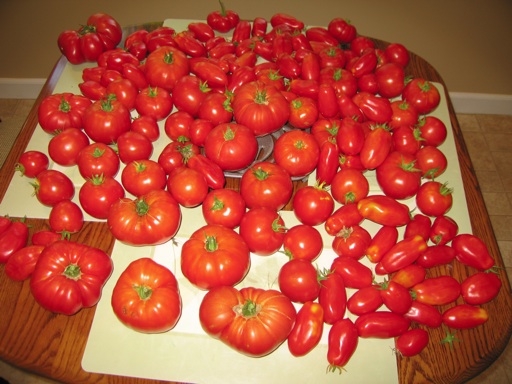
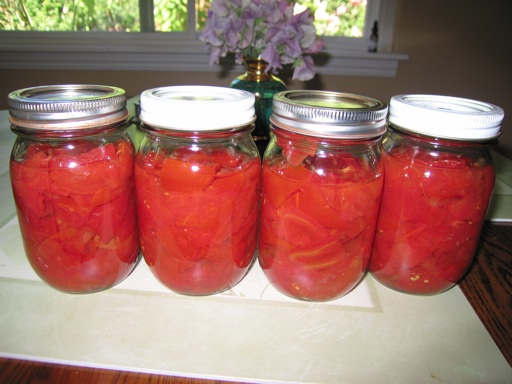
This year, I planted only four tomato plants. The varieties I selected were Big Beef, Beefsteak, Beefmaster, and San Marzano (a plum tomato). I planted nursery transplants in mid-March to give them a head start on the growing season. They grew quickly even in our mild early spring weather, when the highs were only in the 60s. By mid-July, they had ripe tomatoes.
Our Beefmaster tomato plant started to die before it produced many tomatoes. But our other three tomato plants have produced hundreds of tomatoes. Two weeks ago, I harvested all the tomatoes shown on the table in the above picture. We couldn’t possibly eat all of these tomatoes before they went bad, so I canned most them.
The San Marzano tomatoes are ideal for canning. The other varieties are often eaten fresh, but I decided to can all four varieties. I just canned them as plain tomato slices, which is a lot less work than making a tomato sauce first and then canning the sauce like I did in previous years.
I began by slicing each tomato into sections small enough to fit into the jars. Then, I removed the tomato seeds using my fingers, although I wasn’t able to remove them all. That part alone was at least 90 minutes of work for 2 people. I didn’t bother to remove the tomato skins. Removing the skins requires an additional step that is a lot of extra work for so many tomatoes. I don’t mind tomato skins in my food. I usually end up pureeing the canned tomatoes before I use them in a recipe anyway. But I don’t like lots of seeds floating around in the jars.
After cooking the sliced and de-seeded tomatoes in boiling water for 5 minutes using a hot pack method, I packed each jar with tomatoes and some lemon juice for extra acidity leaving about 1 inch of space from the top. Then I processed the jars in a pressure cooker canner at 10 psi for about 25 minutes. I filled about 18 jars with about 3/4 of the tomatoes. (if you use a pressure cooker, be sure to follow the product directions of use carefully). Tomatoes canned this way can be stored for up to a year at room temperature. I used this same technique last summer to can tomato slices. We used our canned tomatoes for more than 6 months before we ran out of them.
August 25 2012 | Tomatoes | Comments Off on Canning Tomatoes
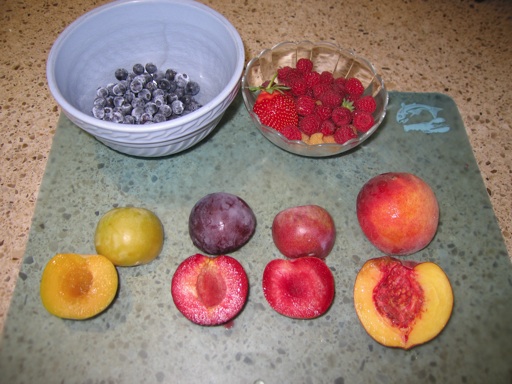
Today, I harvested and ate our first flavor queen pluot. It’s the greenish fruit on the left in the above picture. It had a very mild, somewhat sweet, flavor with no tartness. I thought it tasted nothing like a plum. I have read that flavor queen can be extremely sweet, but our weather has been so mild lately (highs in the mid-70s) that it may not have been able to reach its full sweetness potential.
I have now tasted all four of the pluot varieties from our multi-grafted pluot tree, flavor king, flavor queen, flavor supreme, and dapple dandy. I like all 4 varieties. Each one is different in color and taste. The dark purple fruit in the above picture is a flavor king. It has a nice plum-like flavor. It tastes better than most plums, except maybe Laroda plum. The skin is just a bit tart, no where near as tart as Santa Rosa or Beauty plum.
The pink fruit in the above picture is a dapple dandy pluot. The dapple dandy scion of our very small multi-grafted tree has produced at least 3 dozen pluots this year, many more than the other 3 scions. The fruits have been hanging on the tree in a near ripened state for a few weeks. The first dapple dandies I picked last month were tart. But now they are sweet with very little tartness. Like flavor queen, they taste nothing like plums, but they are sweeter than flavor queen (at least ours are). Dapple dandy may be my favorite pluot of our 4 varieties, because of the combination of producing lots of fruits and its nice mild fruity flavor.
The flavor supremes ripened over a month ago, which is why I wasn’t able to put one in this picture. They also have a delicious flavor that is somewhat plum-like.
The fruit in the lower right of the picture is one of our first O’Henry peaches of the season. Our O’Henry peach tree is now 10 years old, and I have eaten a lot of them over the years. The weather has a big effect on the flavor of our peaches too. Our O’Henry peaches so far haven’t been very sweet. They’re not too tart, just kind of bland. Again, I blame it on the mild weather. It takes some heat (80+) for several days to get them sweet. Last year, the first 2/3 of our peaches were plain tasting. But in the last week of August, we had several days of warm weather (mid-80s-about 90) and the peaches that ripened after that warm spell were sweet and very tasty.
The blueberries, raspberries and strawberry in the bowls are also from our garden. There’s not many strawberries or blueberries left to harvest, but our red and yellow everbearing raspberries are just starting to produce a lot of berries.
August 17 2012 | Peaches/Nectarines and Pluots | Comments Off on Fruity Flavors
« Prev - Next »








